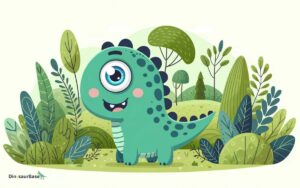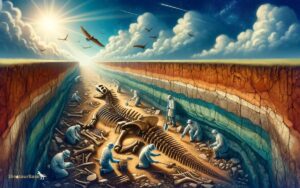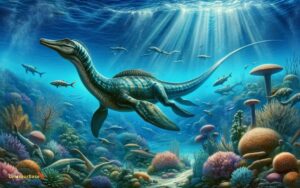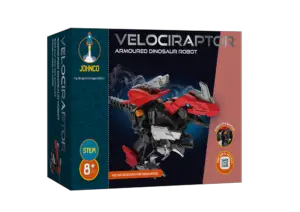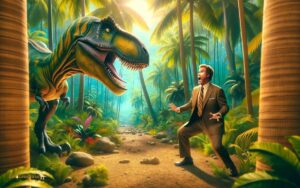When a Dinosaur Dies: Unveiling Prehistoric Mysteries
When a dinosaur dies, its remains can become fossilized if conditions are right. Fossilization is a rare and complex process.
Understanding the fate of dinosaurs following their death provides a fascinating insight into prehistoric ecosystems. Dinosaur fossils are gateways to the past, offering critical clues about the behavior, evolution, and environment of these ancient creatures. The process begins when an animal perishes and its remains are quickly covered by sediment.
This prevents decomposition by oxygen and scavengers. Over time, minerals infiltrate the bones, replacing organic material and turning them into stone-like fossils. These remnants, preserved for millions of years, are often unearthed by paleontologists who piece together the history of life on Earth. Dinosaur fossils not only stimulate the curiosity of the scientific community but also capture the public’s imagination, furthering our collective knowledge about the majestic creatures that once dominated the planet.

Credit: www.ebay.com
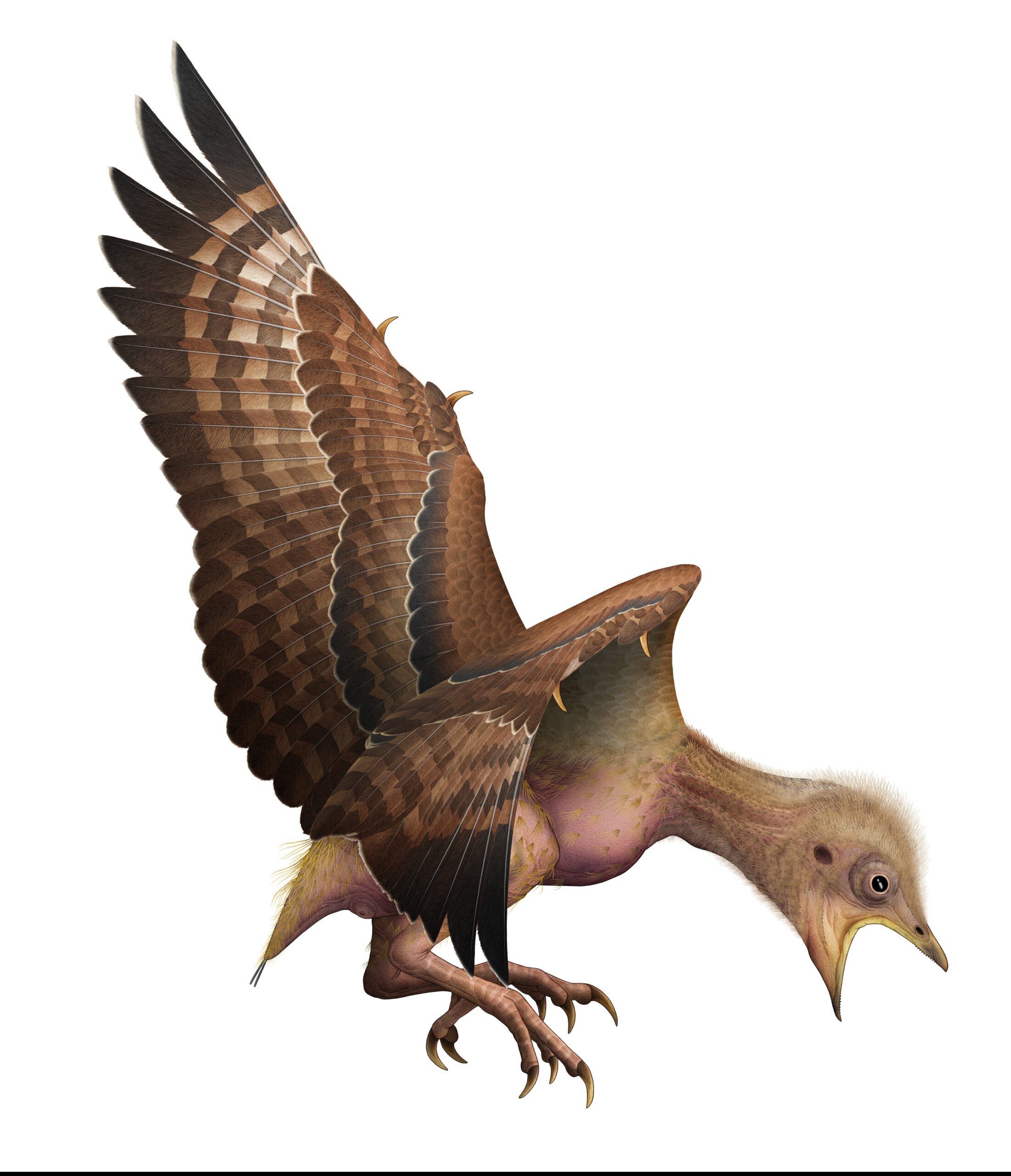
The Final Roar: Unraveling A Dinosaur’s Demise
Imagine a prehistoric world with massive dinosaurs roaming the land. Now, consider what happens when a dinosaur dies. Insights into their final moments and the aftermath are as fascinating as their lives.
Fossil Evidence And Death Poses
Dinosaur skeletons tell tales long after their death. Fossils help us unravel these ancient stories. Scientists study fossils to understand dinosaurs’ lives and deaths.
- Fossil quality: Good preservation provides more clues.
- Positioning: How bones lie gives death hints.
- Surrounding sediments: These reveal the environment at the time of death.
One famous fossil clue is the “death pose” – head thrown back, tail extended. It’s a common position for dinosaur skeletons. It suggests agony in the moments before death.
Analyzing Bone Trauma And Pathologies
Dinosaurs’ bones may show signs of injuries. Examining bone trauma provides insight into possible causes of death.
| Type of Injury | Possible Causes | Example |
|---|---|---|
| Breaks | Falls, attacks, accidents | A broken leg bone |
| Healed fractures | Old injuries, survival | Scars on a rib |
| Pathologies | Diseases, malnutrition | Holes in skull bones |
Scientists also look for disease signs in bones, known as pathologies. This can indicate a dinosaur’s health before it died. Pathologies can show cancer, arthritis, and infections.
Each fossil find adds to our knowledge of dinosaurs’ lives and their end. With each discovery, their stories grow clearer.
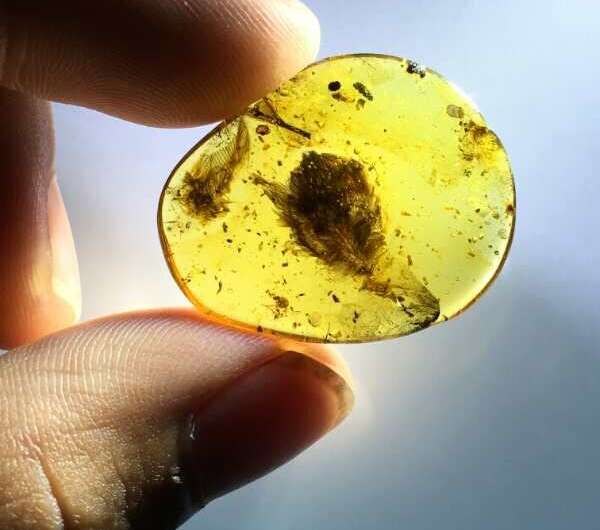
Credit: phys.org
Dinosaur Graveyards: Clues To Mass Extinction Events
Dinosaur graveyards provide a fascinating window into the ancient past. Buried beneath layers of earth, these sites reveal the life and death of creatures from an age long gone. Yet, beyond their skeletal remains lies an even greater tale: the story of mass extinction events that erased dinosaurs from the planet.
Sediment Layers Tell A Timeless Tale
Unearthing the secrets of the past often begins with the ground beneath our feet. Sediment layers act as pages in Earth’s history book.
- Each layer marks a specific timeframe.
- Scientists can date these layers and match them with fossilized remains.
- This comparison gives clues to environmental conditions of the era.
The arrangement of these layers paints a picture of chronological events. Over time, as sediments accumulate, they capture evidence of the world as it once was. From volcanic ash to pollen grains, these microscopic details help elucidate the mysteries surrounding dinosaur graveyards.
The Role Of Cataclysmic Events
In exploring the cause of dinosaur extinction, cataclysmic events stand out.
Asteroids and volcanoes, for example, can drastically alter the Earth’s atmosphere and surface.
| Event | Impact |
|---|---|
| Asteroid Impact | Climatic shifts, dust clouds blocking sunlight |
| Volcanic Eruptions | Release of toxic gases, long-term climate change |
By studying the geological records at these dinosaur graveyards, researchers can piece together the timeline of these disasters. Massive craters and layers rich in iridium — rare on Earth but common in asteroids — signal such events. This evidence frames our understanding of the dinosaurs’ sudden demise. It also sheds light on the fragility of life on Earth, and how swiftly it can be disrupted.
Life After Death: The Fossilization Process
The saga of a dinosaur doesn’t end at its death. In fact, for paleontologists and enthusiasts, it marks the beginning of a wondrous journey—the process of fossilization. This natural phenomenon preserves the remains of these ancient beasts for millions of years. Understanding how a dinosaur transcends into a fossil is both fascinating and complex.
Minerals Replace Bone: Permineralization Explained
When a dinosaur bone gets buried under sediment, an incredible transformation begins. Groundwater, rich in minerals, seeps through the porous bone. Over time, these minerals fill the spaces within the bone. This process, known as permineralization, is akin to nature’s intricate casting method. Gradually, the original bone fades away, and what remains is a stone replica, a fossil that can endure for eons.
- Groundwater carries minerals like silica or quartz.
- These minerals infiltrate the bone’s empty spaces.
- Bone structure remains intact but becomes rock-like.
Exceptional Preservation: Soft Tissue And Feathers
It’s rare, but sometimes soft tissues and feathers also succumb to fossilization. Such remarkable cases occur in exceptional conditions, often involving rapid burial and the absence of oxygen. Thus, microorganisms that would generally decompose organic matter can’t survive.
The soft tissue might undergo a process known as carbonization, where the material decays to leave behind a thin, carbon-rich film. Feathers, with their delicate structures, can also become encased in amber or sediment, revealing intricate details for scientists to study. This high level of preservation provides invaluable insights into the appearance and behavior of these prehistoric creatures.
| Condition for Preservation | Result |
|---|---|
| Rapid Burial | Protects from elements |
| Lack of Oxygen | Prevents decay by microbes |
| Presence of Resin or Fine Sediment | Encases and preserves details |
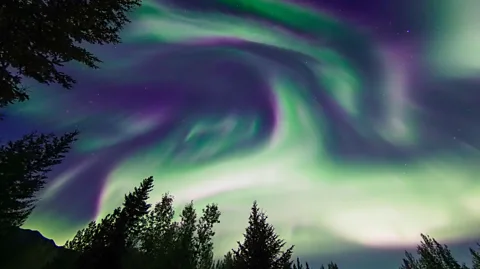
Credit: www.bbc.com
Interpreting Prehistoric Behaviors From Death Sites
The mystery that surrounds the lives of dinosaurs often unravels at their death sites. Paleontologists can decode daily activities, survival strategies, and social behaviors of these ancient giants. By investigating the final resting places of dinosaurs, scientists unlock stories from millions of years ago.
Nesting Grounds And Dinosaur Parenting
Fossils of eggs, hatchlings, and adult dinosaurs together hint at rich nurturing habits. The discovery of these nesting sites presents clues on how dinosaurs cared for their young. Experts interpret detailed accounts of parental behavior from these prehistoric nurseries.
- Communal nesting spots suggest that some species raised their young in groups.
- Organized nests indicate a systematic approach to parenting.
- Presence of eggshells and bones of varied ages help scientists imagine the cycle of life and death in these ancient crèches.
Evidence Of Predatory Behavior In Kill Sites
Scattered bones with bite marks paint scenes of predator-prey interactions. Carnivorous dinosaur fossils found alongside their prey offer a vivid image of their hunting techniques. Bone fractures and teeth embedded in skeletal remains serve as direct evidence of fierce battles.
| Sign | Interpretation |
|---|---|
| Teeth marks | Feeding habits and predator sizes |
| Healed bones | Evidence of survival from attacks |
Reviving Ancient Giants: Paleontological Techniques
Discovering dinosaur remains is like unearthing a treasure trove from a bygone era. Fossil hunters and paleontologists use groundbreaking techniques to piece together the lives of these ancient giants. Advanced technology helps us understand their fascinating world better than ever.
Modern Tech Meets Ancient Remains: CT Scans and 3D PrintingModern Tech Meets Ancient Remains: Ct Scans And 3d Printing
CT scans and 3D printing are changing the game in dinosaur research.
- CT scans allow scientists to look inside fossils without damaging them.
- They reveal hidden structures like ear cavities and brain cases.
- Researchers use these images to create 3D models.
- 3D printing these models lets us touch and study the bones up-close.
These insights bring us closer to understanding these magnificent creatures.
Carbon Dating and Isotope Analysis: Timing the ExtinctCarbon Dating And Isotope Analysis: Timing The Extinct
Carbon dating tells us how old the dinosaurs are. Isotope analysis gives clues about their lives.
| Technique | Purpose |
|---|---|
| Carbon Dating | Measures fossils’ age |
| Isotope Analysis | Checks diets and temperatures |
Together, these methods time-travel us back to when dinosaurs roamed the Earth.
Extinction Speaks: Warnings From The Past
A long time ago, giant creatures called dinosaurs roamed the Earth. When dinosaurs died out, it wasn’t just an end. It was a message. Extinction Speaks: Warnings from the Past uncovers these messages. We learn what can happen if we are not careful with our environment.
Modern Ecosystem Parallels
Today’s animals and plants might face risks like the dinosaurs did. Changes in climate and habitats can threaten them. We see similar patterns and ask, “Are we next?” By studying dinosaur extinction, scientists try to protect future life. Let’s peek into these parallels:
- Climate Shifts: Dinosaurs faced big climate changes. Our world is changing fast, too.
- Habitat Loss: Dinosaurs lost their homes. Many animals today face the same problem.
- Human Impact: We change the land. It can lead to trouble for creatures living here now.
Conservation Lessons Derived From Dinosaur Data
Dinosaurs teach us how to save today’s wildlife. Their bones hold secrets from the past. Here are some conservation lessons we’ve learned:
| Dinosaur Data | Conservation Lesson |
|---|---|
| Diverse Diets | Protecting different plant types helps animal diets. |
| Migration Patterns | Keeping land routes open is important for animal travels. |
| Social Behavior | Groups of animals need large, safe spaces to live together. |
Conclusion
The passing of a dinosaur, though eons past, still harbors lessons for us. Their extinction reminds us of nature’s power and fragility. As we unearth more about these ancient giants, our wonder grows. Let’s preserve their legacy by learning and protecting our planet’s biodiversity.
Together, we can ensure life thrives for millennia to come.

